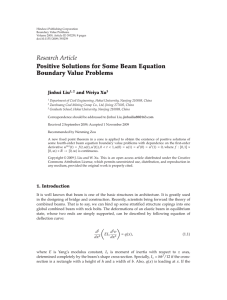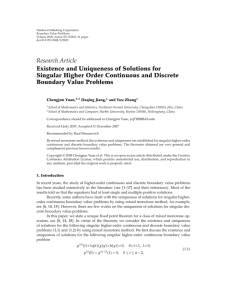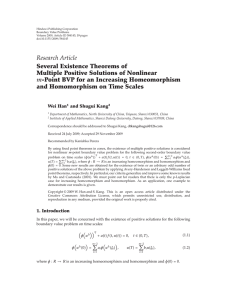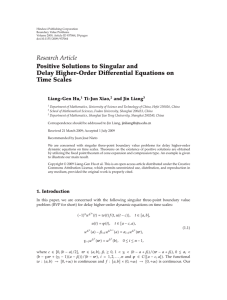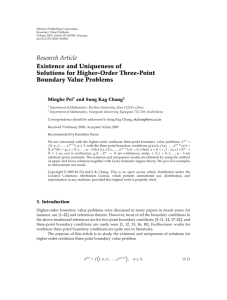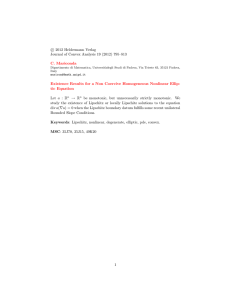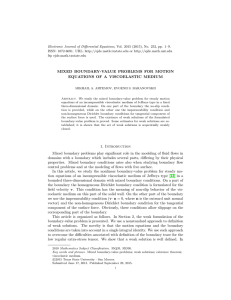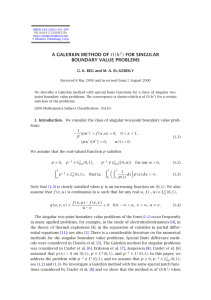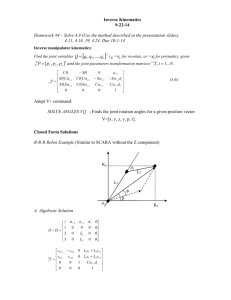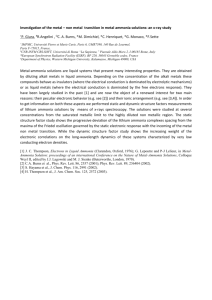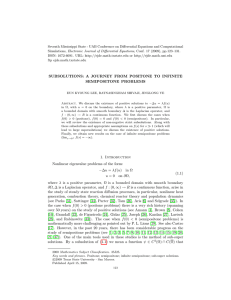AND FOR EXISTENCE OPTIMALITY
advertisement
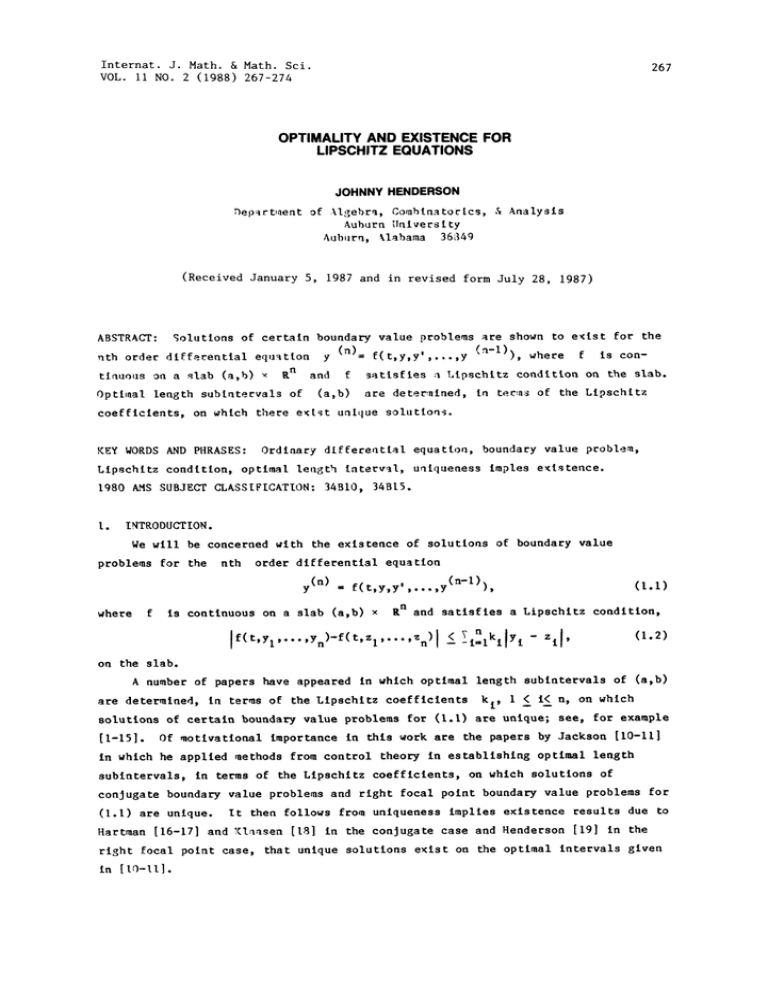
Internat. J. Math. & Math. Sci.
VOL. ii NO. 2 (1988) 267-274
267
OPTIMALITY AND EXISTENCE FOR
LIPSCHITZ EQUATIONS
JOHNNY HENDERSON
Del)act,ent of Igebra, Combtnatoc[cs, & Analysis
Auburn University
Auburn, labama 36849
(Received January 5, 1987 and in revised form July 28, 1987)
ABSTRACT:
Solutions of certain boundary value problems are shown to eIst for the
nth order dI.ferantlal equation Y
Rn and
tIauois oa a slab (a,b)
Optimal length subintervals of
(n)__ f(t,y,y’,...,y fn-l) ),
where
f
is con-
atlsfles a Lipschltz cond[tkon on the slab.
f
are deter:nlned, [ tems of the Lipschitz
(a,b)
coefficients, on which there e[st u[que solutions.
KEY WORDS AND PHRASES:
Ordinary dlffereattal equation, boundary value problem,
LlpsehItz condition, optimal let, gth interval, ualqueness Imples etstence.
1980 MS SUBJECT CLASSIFICATION: 34BI0, 34B[5.
l.
INTRODUCTION.
We will be concerned with the existence of solutions of boundary value
problems for the
nth
order differential equation
y(n)
where
f
is continuous on a slab
f(t,y,y’ ,...,y
(a,b)
R
n
(n-l)
(1.)
),
and satisfies a Lipschitz condition,
on the slab.
A number of papers have appeared in which optimal length sublntervals of (a,b)
< i< n, on which
are determined, in terms of the Lipsch[tz coefficients kl,
solutions of certain oundary value problems for (l.l) are unique; see, for example
[I-15].
Of motivational importance in this work are the papers by Jackson
[I0-11]
in which he applied methods from control theory in establishing optimal length
subintervals, in terms of the Lipschltz coefficients, on which solutions of
conjugate boundary value problems and right focal point boundary value problems for
(I.I) are unique. It then follows from uniqueness implies exlstence results due to
Hartman [16-17] and (laasen [18] in the conjugate case and Henderson [19] in the
right focal point case, that unique solutions exist on the optimal intervals given
in
268
J. HENDERSON
la
[7-8],
we adapted-ackso,l’s coatr,)l theory arguments, [q c,)nj,1ct[on wth
u[qaees- [,pl[e e[.tece
(a,b)
teals of
e,It, ad
determined optimal length
on h[ch thee et m[que sol.t[os of seerl classes of
boundary value pobl.e.,s ..) third
an
fo,Jth order ordinary differential equat[o
sat[sfylag L[pschItz cond[tIons.
In a recent ork [9], we followed the pattera of
[7-, i0-[I], by applying the Po,tryg[a Mx[mu Pr[,l.zIple to a llnearIzt[on o6
(I.I), and determined opt[,,al le,gth s,,b[ntervals of (.,b), In terms o k[, on which
ol.]t[ons are unique for boundary value problens for
Y(1)(tl)
<
.,<
h
lq
_<... <_%_
thls work,
.at
now
<b,
0_<k<.<_.,
the prob!e,n
ad|res
k
Yn-h+(I+l)’
o.
([.1) sat[sfyIng
.
_<
I
h-l,
,, t_<
existence of solutions of
(1.9) on the optI,,al Intervsls for U,l[.Iseness .!-%[e,l In [9].
o
some
,
Then l Section
subintervals of length less tha the optimal
certaln values of
k
and
k
h, sol.at[ons of
and
oP’rlMAL[TY AND
we are able to prove that on
!enth
([.I), (l.)
given
s
h, the e.[tence result
so:,e
n
2 and for
For It, Is restricted
gect[o
exist.
sense analogous to the
[16-19].
iqueness lmpl[es existence results In
2.
We ste In Section 2
t1e results concerning optimality and ualqeness obtalned [n [9] which are
pert[,ent to the argument here.
set f
i<_
UNIQ!JENESB.
In this sectlon, we state a Theorem and a Corollary from [9, Thm. 3 & the
Cot. I, In hlch optimal length subintervals of (a,b) In terms of the Lipschltz coefflcIents ki,
I
n, are deteralned on which solutions of ([.), ([.3) are
[,lue
THEOREM 1.
Let
O
k
<
h
n
be given afld let
mtnfTlk
y
Is the ’,alle.t positive nu=.ber such that there exists a solut[on
bounda value problem
x
(n)
(-l)h-[klx +
x
,,I)
(O)
(t)
O, O
o
(’
with
x(t) > O
k
<
a
h, ff
< t{ < te
(a,b),
on
y(t)
-.. <_
(O,)o
or
+
Y.
zt)
and
<
b,
],
x
i
i
<
n-h+-l,
<
t
<
h-t,
If no such solution exists.
-
For any
are d[stlnct solutions of (l.l) such tl,at
(1)(t,) z()(t), o <
y(i)(t I) z(t)(tt),
<
k
< h}, where
x(t) of the
an,]
.nd thls is best possible
!..,’:
or
th_
i
t{ <
<
n
h +
_< i <
h-
,
,,
y, It follows that
y(t)
the class of all dlffereattal equations
.satisfying the T0[psch[tz condition (1.2).
z(t) on
OPTIMALITY AND EXISTENCE FOR LIPSCHITZ EQUATIONS
REMARK.
;Io.,,;
Jacks,,.
[]
for the case when
?.-)cod Theorem
’,.;
of length less th:,.=: r:’.
,a -.,Iblatervals
y
,:t;nt
269
h
O.
k
and
n
in Theorem 1, it
f3llows from Rolle’s Theorem that solutions of a number of other h,,..-.,-y alue
.
(1.I) are unique. For exa.ple, we can state the following.
,c .ay k <
COROLLARY 2. Let y be as [a Th.,r.,
< h and
probi..,q for
!
y(t)
h, if
are solutions of (l.l) such that
z(t)
and
,
y(1),tl,) z(1)(t I’), O _< _< n-h + -I,
y(i+J-h)(t i) y(i+J-h)(tl), < < h-l,
i
i
a
<
t < t. S
(a,b),
3.
<_ th_ <
b, an,’,. ;V
y(t)
Y .t ollows that
:i
:h-I
z(t) on
and this is best
EKISTENCE OF
:t,t.".l.eness implies existence results proved by Hartman [16-17],
Klaasen [18], and Henderso 19], we gve a proof [n this section ti:, ,,t the
optimal sublnterals for unlquene:.’ J-,.t,::":...t.! [a Section 2 and for a restricted
Analogous.::
:;,:’.’: ,,f
t.,
values of
h
g.l:e .,.rr,hlems
k, the boundary
and
(I.I), (1.3) have
unique
ttons.
For the proof, we use somewhat standard shooting method: ’,l.q .!".1 zive
the proof only for two-polnt problems, wtth the p,.’.? f:-,r multlpolnt problems being
;,i
sinilar.
THEOREM 3.
function).
Then the
Let
bounda
Let in/2]
k
0
<
<
h
be .given, ([.] denotes th.,. j,r,.;-.::t-, integer
n
min{y[
y
and let
(t, y, y’,
y[)(t)
Yt
<
’
t
h}
<
<
J i J n,
<
g
b, 0
be as defta.!
[.q ’?h)em
provtde t
2
t
<
(n-)
),
t’
t
a unique solutto, ?,r
..’..ignment of
Furthermore, thls eIt
y.
[s best possible
for the class of all differential equations which satisfy th :," .t.
(.2).
)OF.
give.
Let
I.
n-h+t-[,
i
’n-h+(i+t)’
s
h,
y
Yi+’ o S
(2)
Y"
a
<t<
value problem
(n)
where
0
a
We prove the
<
<
t
2
,xthace
<
b, with
t
2
t
<
y, and
j
J n,
be
of solutions for a much larger family of boundary
vale problems than those in the statement of the theorem
In fact, we prove the
existence of solutions of the two-point problems which bel)g
prohle’., la Corollary 2.
’
Yi
For induction
pltl)oq;
J,
,
tha :lass of
:ctange these problems in a
lower triangular array,
(I,I)
’:’" l.)
(2 2)
(h,l)
(h,2)
where the bo,.aa’y ,,,:.flue problem for (I) associated with the
(,v)-posltlon,
270
<
J. HENDERSON
<
<
u
h, satisfies
y(i)(tl)
y(t)(t2
Yi+l,
O
_< i < n-v-l,
Yn-+(i+l)’ -v <_
t
Under this arrangement, the boundary value problems for (1.1) along the principal
diagonal
(u,u),
u
h, are
e.onJuga_t_e
type problems, whereas the boundary value
problems In the statement of this theorem are assoelated Ith the entries along the
(h,v),
< v < h.
By Corollary 2, solutions of all the problems In th[ array are unique on
bottom row
subintervals of length less than
.
Moreover, by the constraints on
and
h
k, It
follows that solutions of all conjugate type boundary value problems for (I.I) are
unique.
Then
it
follows from the uniqueness i,aplIes existence result of Hartman
[16-17] and Klaasen [18] that the c,>,ljigate boundary value problems, and in
parti-
cular those associated with the e,tctes on the maln diagonal, have unique solutions.
(This is the reason for the constraints on
h
and
k.)
For existence of solutions
of the remaining problems associated with the array, we will use the shooting method
coupled wlth an Induction along the subdiagonals on the array.
In that direction, choose any boundary value problem for (I) associated with the
first subdlagonal
(,u-l),
2
where
<
<
h; that Is, e are concerned with
solutions of (I) satisfying
Y(i)(t2)
<_ I <
Yn-B+(i+l)’
-I.
In applying the sho,->t[,xg method, let z(t) be the solution of (I) satisfying
conditions associated with the (u,u)-positfon,
z(1)(t)
z(t2)
z(t)(t2
y(n-)(tl)lY(t)
S
and define
z(1)(tl ), O _<
z(n-u)(tl) S,
n-u-l, and
i
e
yi+, o
<_ _<
O,
<- i <- u-t,
Yn-u+(i+)’
is a solution of
y(i)(t2)
y(i)(t I)
(I) satisfying
z(f)(t2 ),
< i < -I.
S
and since solutions of the problems corresponding to
since
$
(B,-I)-
position are unique, it follows from a standard application of the Brouwer Invariance
of Domain Theorem that
We claim that
S
S
(see [20-211
is open,
for a typical argument).
is also a closed subset of
false, It follows that there is a limit point
strictly monotone sequence
out .loss of generality that
rj) S
of (I) given by the definition of
S
0
Assuming the claim to be
e S \S.
Hence, there
exists a
of numbers converging to r
O.
We may assume with-
J > I,
denote the solution
For each
rj/rO.
r
R.
satisfying,
let
yj(t)
OPTIMALITY AND EXISTENCE FOR LIPSCHITZ EQUATIONS
"(t 1)
y
J(n-)
"(tL)
z
.vj(1)(t2 z(f)(t2 ),
Futeote
oc
! !
1
yj(t) < Yj+l(t)
I,
each
(tl,t2].
on
satLsLes the LlpschLtz codLtLon (2) t follos that a
o (L) Is satisfied, (see [I0]);
f
slice
<i<
O
J
tl
Fro Corolla 2, it follows that,
271
,
compactness eodtLo on sequences of solutLons
ts compactness coudtLon d the fct that
rO
(a,b),
uuformly bou.lT .a ch compact subLnterval of
n
aud
Ls ot
{yj(t)}
h.e tlat
s
prtLcular,
not
[tl,t2].
uufoly bounded above o each eo,npact subtrql of
ow let (t) be the soltLo of the proble for (l) assocLated wth the
(u-l,u-l)-pos{t[on,
u(i>(t)
y[+, o i I
u(n-’)(tl)
u(t2)
0’
O,
u(i)(t2
It follows that,
or
and either (I) (-I)
[s
odd, or (l)
I+I
Yl
([) (t)
(t)
< =() (t)
(-[) [+lu([) (t) on
< (-1)[ u ([) (t)
(-l)[Yl()(t)
We will assume that
is even.
<
-u
u
lntesect
Ok+t I.
(n-u) (t)
or
(t)
Yl
.
point
at a po[nt
o
o
k
e
n-, when
$)
+ $)
,
(t
and
t
I)
nd
+
ate
.
I,
yj k (n-u)(t)
Ok+t
and
the first points where these intersections occur.
{yjk(t)},
(-l)l+lyl({)(t)
[F there [s an lnfln[te subsequence, which we relabel as
YJk (n-P)(o k) yl(n-u)(Ok ), e have that, for each k,
< (-)[+t ([)(t) < (-t)[+ u ({) (t) on (Ok’ tl)’ O
YJk
case
l[m yjk ([)(o k) yl([)(tl), O < I < n-. But, it
k+
YJk(l)(t 2)
<
n-
such that, for each k
(tl’ tl
e
I
(t[
2
i
n-u, when
O
t
{yjk(t)}
Pk
t
(tt-, t[),
is odd and also that
at
O
I + ),
(tl,
on
By choos[ng successive subsequences and telabel[ng, we may assume that
tl- < k < tl< k < tl
Now,
u(-u)(t)
[tesects
U-2.
(tl-$, tI),
on
It follows that there eElsts a subsequence
y k (a-u)(t)
<_ i !
Yn-,,+(+[)’
O, y
soe
! n--t,
y
({)(t 2)
<
I
<
u-I
n-u.
such that
In thls
[s also the case that
and so fmom the continuous dependence
o
solutions
272
J. HENDERSON
(u,J-l)-pos[t[on, tt follows
on boundac/ conditions of proble:s ass.oc[at.d with the
t
<t)
tlla
0
< n-.
<
l[)(t)
converge. Jn[f.or.,ly t.
(a,b),
on compact sb[ntevIs of
This [s [,,p,,l’le,
Jk
Jk
In the cse that there
Yjk(t)’
yjk(n-)(Ok u(n-)(Ok
such th:t
follos that, for each
(ak’ t])
Yl ([)(t) < Jk ([)’t)
and
yjk(n-u+l)(k (n-u+l)<Yk)
u
()
(t I), O
! ! n-u,
([)
(-l)[+ly
k,
soe
Yk
k+
YJk ([)(t 2) u([)(t2 ),
case that
e
(tl,0k)
on
(ak’k)"
!
,-2.
gu,ent similar to the one
and the fact that
t
2
(t
use.
<
)
[n the
! !
u
(n-u+l)
(tl);
0
t
follows that
,(n-u)(tl)
Thus, q
yjk(1)(a
k
[t [s .iso the
(u-l, u-2)-pos[t[on coupled
with
th[
latter type of problem for
u{[)(t)
[t follows that
on compact subintervals of
(a,b),
u(U-1)(t2
In partteulr,
1,
llm
k
proof of the first theorem of [13, Thin. I]
y, solutions of
cosverges un[o=ml to
on
n-u, and
([) are unique and thus depend cont[uously upon boundary conditions;
([)(t))
It
From un[q,eness of solutions of
boundary value problems for (I) corresponding to the
,
O
(-l)i+lu([)(t)
<
It follows that
yjk(n-u+l) (k
l[m
and that
([)(t)
[+I.
,,(1)(t)
f
yjk(n-)(0k) u(n-)(0k)’
a,d
e 3; again, a contradiction.
r
0
S
is qlso ,losed and hence
R.
Choosing
Yn-u
e
S, e corresponding
solution of (I) satisfies the
(,,,-l)-pos[t[on.
subdtagonal,
bounda value problem corresponding to the
Hence, boundary value problems for (t) associated with the first
(,u-l), 2
<
u
<
h, have unique solutions.
? < I < h and that, for each
For the induction, assume o th
the
bodnda
(,u-. )),
<
s
<
m,
value problems for (I) associated with the subdtagonals
< u < h, ve unique solutions
m+l, we n rgue that bou,da value problems for (I) corresponding to
the subd[agonal (u,u-m), where I < u < h, have unique solut[ons. Choosing any
snch (u,-), we are concernel ;.t’ o],,t[ons of (I) stisfy[ng
For
s
s
Y
()
(t2)
For the shooting schedule here, let
z(t)
Yn-u+(i+l)’
m
<
<
u-l.
be the solution of (1) corresponding to the
OPTIMALITY AND EXISTENCE FOR LIPSCHITZ EQUATIONS
(., U-(m-I )-pos
Ion
z(1)(tl
z(m-l)(t2
:,."
In ths eas, dfta
tl)
,
manner analogo
,
Is bsth
solution of (I)
<
<
i
-., ,,:,
<
<
u+m-2,
O,
"
:n-u+(1+l)’
z
I
It aaa be argued that
R.
(t) satisfying
is a
y(1)(t2)
n-,-2, and
S
’l-
(t2)
m
<
i
<
In a
u-l}.
R which
Is a aonempty subset of
Yn- SI’
Choosing
the :orespoadlng
Heace, bounda valde problems for (I)
h, have unique solutions.
(,-m), I
for (I) ..,<-,ted wlth each
problems
value
nductlo, bounda
the :,:[,?,-d olut[o.
ll.goaal
Therefore, by
n
,,’,t2"
O
Yi+l’
cY(n--l)(tl)lY(t)
$1
O
[)
I ,losed, so that
assocl:t.,1
entry
273
-.
I t’e coacluson of the
t1e trlaagular array have ualqe sol,t,,
theorem holds f=om the c
:,-,-?qspoad[ag to the bottom row
(h,),
<
<
h.
IIsl,lg .’..l,J..’,.j .,.thods and an Ind,lctIoo slmllar to bove, one can prove
exlstence of solutions
ht.i,,l,t bounda value problems (l), q ;th the same
constraints on
and
h
Let
THEOREM 4.
,/2]
.
,..
k.
n be glven.
h
be as defined In Theor I.
Then the
O
Let k
and let
y
,, yJ
O
.
<
h}
bouda value problem
y(U
where
meat of
a
<
<
t
y
R,
Eor the class of
(.2).
-1 <
t
1
b, 0
a, provided
,tl l[rr:e,t[al
<
tl
<
h,
t
s
<
a unique solutoa for aay
y.
This result
s
best
quatons which satisfy the Lpseh[tz eoadtlon
R., Best possible length estimates for nonlinear boutd,’y
Bull. Inst. Math. Acad. Sinlca 9 (1981), 169-177.
?.
assgn-
.,,,:tl
AGARWAL, I.’,, end CHOW, Y., Iteratlve methods for a fourth order boundary value
problem, J.____.C.o.m.p. Appl. Math. I0 (1984), 203-217.
.
and WILSON, S., On a fourth orde b,,,,la=y value problem, Utiltas
3. AGe’I;\,,
M:t. 26 (1984), 297-310.
4.
GINGOLD, 8., ’l,[q...ness of solutions of boundary value problems of systems of
ordinary dfi..t[;l ..*.q.atlons, Pac. J. Math. 75 (1978), I07-13(.
274
5.
GIqGOLO,
..
J. HENDERSON
Tn,,-:..
:.:;
,.’r[terta
problems, J. Math. Anal. Appl. 73
6.
for econd order nonlinear boundary value
(1980), ]92-410.
GINGOLD, H. and GUSTAFSON, G., Uniqueness
oc
nth
order de la Vallee Poussin
(1985), 201-220.
boundary valle problems, ppllcable Anal. 20
7.
HENDER:), .I., Best interval lengths for boundary value problems for third order
Lipsch[tz eq,tlons, SlAM J. Math. Anal., in pre.
8.
HENDERSON, .I. and MCGWIER, R., Uniqueness, existence, and optimality for fourth
order Lipsch[tz equations,
9.
HENDERSON, J., Bo,ndry value problems for
:.ath. Anal.
10.
A.p.pl_., In
Equations, in press.
order Ll,p.,.’},[tz equations, J.
nth
press.
.
J,CKSON, L., Existence and uniqeness of solutions of boundary value problems
Lipschltz equat[,,.,.,
II.
.._Dffere,_,tial
Differential Equations 32
(1979), 76-90.
JACK.O, L., Boundary value problems for Lipschitz equations, "Differential
Equations" (. Ahmed, M. ",l.-:e,er, A. Lazer, eds.), Academlc Press, Ne York,
1980, 31-50.
12.
MELENTSOVA, YU.,
best possible estimate of the nonoscillation interval for a
linear differential equatio with coefficients bounded in
Diff. Urav. 13
Lr,
(1.977), 1776-1786.
19.
MELETSOVA, Y:’}, _qq, I[L’SHEIN, G., An optimal estimate of the length on which a
multipoint boundary value problem possesses a solution, Diff. Urav.
1630-1641.
[4.
MELENTSOVA, YU. and MIL’Bq’[EIN, G., Optimal estimation of the nonoscillation
i,tevl for linear .Ifferential equations with
bounded coefficients, Dff.
Urav. 17 (19.BI), 2160-2175.
.;
15.
ROC’{,
16.
{ARTN,%., P., Unrestricted
O, te. interval of dlsconJugacy of linear autonomous differential
equations, SIAM J. Math. Anal. 12 (1981), 78-89.
(1958),
17.
n-para,neter families, Rend. Circ. Mat. Palermo (2) 7
123-[42.
NARTMAN, P., On n-parameter families and interpolation problems for nonlinear
differential equations, Trans. Amer. Math. Soc. 154 (1971), 201-226.
or|inary
18.
KLAASEN, G., Existence
19.
HENDERSON, J. Existence of solutions of right focal point boundary value
theore,,s for boundary value problems for nth order
ordinary dlerentlal equations, Ro_cky Mtn. J. Math. 3 (1979), 457-472.
problems for ordinary d[fferentlal equations, Nonlinear Anal. 5 (1981),
989-1002.
20.
HENDERSON, I., Uniqueness of solutions of right focal p.,[,,t boundary value problems for or.[nary dlfferenttal equations, J. Differential Equation 41 (1981),
218-227.
2[.
JAGKSON, L., Uniqueness of solutions of boundary value problems for ordinary
dlffere,t[a. ,*.q.tloqs, SIAM J. Math. Appl. 24
(1973), 535-538.
